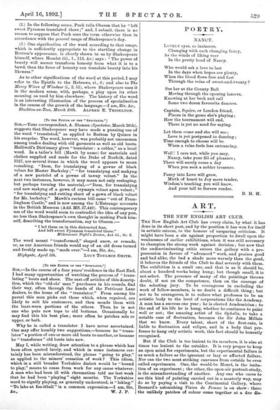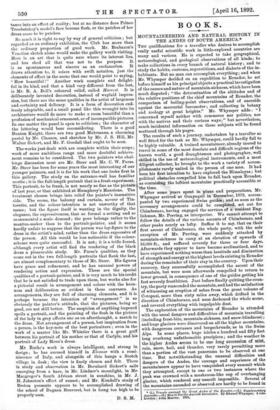ART.
THE NEW ENGLISH ART CLUB.
THE New English Art Club has every claim, by what it has done in its short past, and by the position it has won for itself in artistic esteem, to the honour of unsparing criticism. It might have been a sin against proportion to dwell upon the weaknesses of earlier exhibitions, when it was still necessary to champion the strong work against derision ; but now that the undiscriminating critic enters the gallery with a pre- possession in favour of " advanced " work, and praises good and bad alike, the bad a shade more warmly than the good, it behoves the friends of the Club to deal severely with them. The exhibition is a small one, and that is as it should be, about a hundred works being hung; but though small, it is not select. The presence of many of the paintings throws doubt, if not on the competence, then on the courage of the selecting jury. To be courageous in excluding the work of fellow-members, is no doubt a difficult thing ; bat not to be courageous, is to reduce what professes to be an artistic body to the level of corporations like the Academy. A man has a success one year ; he is elected Academician ; to the end of his life he is hung, whether he continues to paint well or not; the amazing artist of the Ophelia, to take a notable case of fluctuation, becomes the Sir John Millais that we know. Every talent, short of the first-rate, is liable to fluctuation and eclipse, and in a body that pro- fesses to hang only artistic work, this fact should be honestly recognised.
But if the Club is too lenient to its members, it is also at times too lenient to the outsider. It is very proper to keep an open mind for experiments, but the experimental failure is as much a failure as the ignorant or lazy or affected failure. Nor can the two most striking canvases from outside be even called experiments. One, the would-be Monet, is the imita- tion of an experiment ; the other, the open-air portrait-study, is the misunderstanding of another. Any one who cares to see this kind of painting carried out in a masterly way, may do so by paying a visit to the Continental Gallery, where Besnard's astonishing Vision de Femme is on show : there the unlikely patches of colour come together at a due die-.
tance into an effect of reality; but at no distance does Prince Tronbetzkoy's model's face become flesh, or the patches of her dress cease to be patches.
So much it is right to say by way of general criticism ; but regarded as an ordinary exhibition, the Club has more than the ordinary proportion of good work. Mr. Brabazon's Venetian sketch alone would make the gallery worth visiting.
Here is an art that is quite sure where its interest lies, and has shed all that was not to the purpose. It
is as spontaneous and sincere as an exclamation. It -draws attention to, it seizes with swift notation, just the elements of effect in the scene that one would point to saying, "How beautiful !" Another work complete and delight- ful in its kind, and that a kind very different from the last, is Mr. R. A. Bell's coloured relief, called Harvest. It is deliberately invented decoration, instead of waylaid impres- sion, but there are the same qualities in the artist of largeness and certainty and delicacy. It is a form of decoration end- ,lessly adaptable, and a small panel like this wrought into its architecture would do more to make a room beautiful than a profusion of mechanical ornament, or of incompatible pictures. In one matter the panel is open to criticism; the character of the lettering would bear reconsidering. There is a good Buxton Knight, there are two good 3fuhrmans, a charming pastel by Mr. Clausen, and sketches by Mr. J. S. Hill, Mr. Walter Sickert, and Mr. F. Goodall that ought to be seen.
The works just dealt with are complete within their scope; work of more ambitions range and more doubtful achieve- ment remains to be considered. The two painters who chal- lenge discussion most are Mr. Steer and Mr. C. W. Furse. Mr. Steer has been for some years the most interesting of our younger painters, and it is for his work that one looks first in this gallery. The study on the entrance-wall has familiar merits ; it is the fall-length portrait that is a fresh experiment. This portrait, to be frank, is not nearly so fine as the pictutt, of last year, or that exhibited at Humphrey's Mansions. The treatment chosen brings into relief the painter's insensitive side. The scene, the balcony and curtain, savour of Tin- toretto, and the colour-intention is not unworthy of that name; but the figure itself is wanting in the dignity, the elegance, the expressiveness, that so formal a setting and so monumental a scale demand ; the pose belongs rather to the mantua-maker than to the portrait-painter, and it seems hardly unfair to suppose that the person was lay-figure to the dress in the artist's mind, rather than the dress expressive of the person. All this would be less noticeable if the colour- scheme were quite successful. It is not; it is a trifle forced, although every artist will find the rendering of the black dress a pleasurable study. Mr. Furse's qualities, as they come out in the two full-length portraits that flank the last, are almost complementary to those of Mr. Steer. His figures have grace and refinement, and he has unusual powers of rendering action and expression. These are the special -qualities of a portrait-painter, and it is very much to his credit that he is not satisfied to trade upon them, but works also for a pictorial result in arrangement and colour with the keen- ness and deliberation so evident in these canvases. As arrangements, they are full of charming elements, and it is perhaps because the intention of "arrangement" is so obviously the painter's attitude, that the pictures, being so good, are not still better. The suspicion of anything imposed spoils a portrait, and the painting of the flesh in the pictur. e of the lady in grey affects one as an afterthought, a match to the dress. Not arrangement of a person, but inspiration from a person, is the key-note of the best portraiture ; even in the work of a master like Mr. Whistler there is a great gulf between his portrait of his mother or that of Carlyle, and his portrait of Lady 3feux's dress.
Mr. Itoche's work is always intelligent, and strong in design ; he has amused himself in Eleanor with a remi- niscence of Italy, and alongside of this hangs a Scotch village in dusk ; the view is finely chosen and felt. There is study and observation in Mr. Bernhard Sickert's sails emerging from a haze, in Mr. Lindner's moonlight, in Mr- Macgregor's South African street in sunshine, in Mr. J. H. Johnston's effect of sunset; and Mr. Kendall's study of Breton peasants appears to be accomplished drawing of the school of Dagnan Bouveret, but is hung too high to be properly seen.
D. S. M.

































 Previous page
Previous page